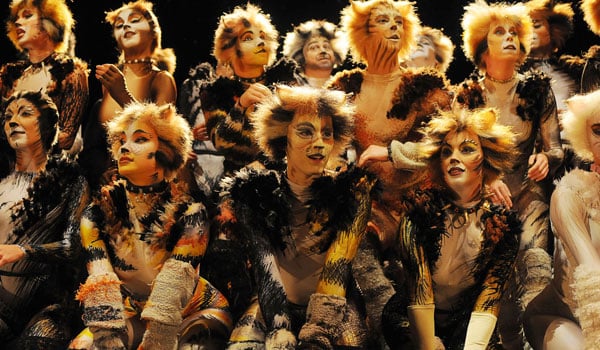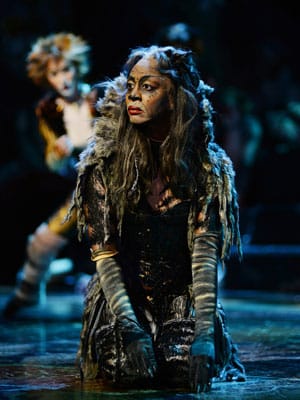
Cats
London Palladium
27/10/15
3 Stars
Book Tickets
‘It’s an experience rather than a musical. People who see the show for the first time can’t quite pin down what it is. They’ve just had a wonderful time.’ – Cameron Mackintosh
Cats was not expected to succeed back in 1981 – Trevor Nunn was known for Shakespeare and not musicals, Cameron Mackintosh had yet to have a proper West End hit, TS Eliot’s theatre work had taken him in very different directions, and Lloyd Webber was proposing a musical essentially through-written with no dialogue and only a wisp of a plot. Yet in a way that has defied complete explanation Cats never looked back. With twenty-one straight years on the London stage alone, those winking yellow eyes have lit up all over the globe like one of those photos of the city lights of planet earth seen from a satellite in space.
How does this phenomenon of the 1980s look now? Now that the revival of 2014 has returned to the Palladium for a brief-ish season, we get another chance to make a judgment. There are some casting changes inevitably, but in essence this is the same show that was reviewed by Stephen Collins nearly a year ago. Many of the points he made then also apply now but there has been some deterioration in the interim.

The first point to make is that the show is a natural fit for the Palladium. While you can’t recreate the theatre-in-the round of the original production, there are still plenty of ways in which the cats can break out into the audience and ingratiate themselves in and out of the aisles. Frank Matcham’s generous sightlines in this lovely old theatre make sure everyone has a good view and is thoroughly involved in the action. John Napier’s famous set contrives to turn trash into bling so that you hardly notice where the rubbish ends and the first-tier boxes begin. So even before the action begins, and during the interval (with Old Deuteronomy on stage for the kids), everyone is brought into a single shared community.
The orchestra, again under the leadership of Graham Hurman, is a very impressive outfit, with tight ensemble and some virtuoso solo work, especially from the woodwind players, who have many plangent, delicate mood-setting moments to negotiate as well. The quality of the band ensured a rock-solid foundation for the elaborately choreographed set pieces. In the ‘Jellicle Ball’ you want each high point to be topped by the next, and thanks to the pacing of the conductor and players it was. The only criticism to be made, and it is a severe one, is that for the whole of the first half the sound was hideously over-amplified. Someone made adjustments at the interval, but by then the damage was done.
This mattered more than it might have done because the first-half and indeed the show as a whole has simply become too long. Running now to two hours and fifty minutes (with the interval), there are points where the material overstays its welcome, especially in the introductory sequence, and the ‘Battle of the Pekes and Pollicles’, both of which could really be pruned to advantage. Things were noticeably sharper in the second act, where the episodes are more varied and self-contained, and where the music is simply much stronger, with less reliance on that endlessly repeated, falling arpeggiated theme that is so dominant elsewhere.
With little plot to go on beyond the flagging of Macavity’s future appearance, and the story of Grizabella, so much rests on the fluency of the direction and the variety and dazzle of the dance routines. Both Trevor Nunn and Gillian Lynne have revisited their work and by and large things still unfurl as well as they did. I am struck again at how classically-informed the dancing is, and therefore how demanding on the performers. There is no room for approximation, and the company deserves great credit for their professional bravura in this department.
However, I do have a few reservations. It may be that In the Heights is still playing in my imagination, but frankly the rap routine for Rum Tum Tugger seems quite tame in comparison with what is now achieved elsewhere, and the text is still only audible at intervals. Moreover, I am conscious after many years away from this show, that for all the aspects of feline behavior captured in dance and direction, there are other possibilities – gentler, sauntering, insinuating moves – that are missing. Yes, we are in a rubbish tip, with feral not flat-based felines, but even so, I feel we are only getting a part of the picture, though a full-on and very exciting one.
The opportunities for characterization of individual cats, and evocation of memories (as opposed to ‘Memory’) are mostly well taken. Here the acting honours belong particularly to Paul F Monaghan who carries the responsibility for Bustopher Jones (here looking like Diaghilev in his ‘Ballets Russes’ pomp), Gus the Theatre Cat, and Growltiger. These are three highly contrasted parts and Monaghan bring pomposity, dignity, pathos and rip-roaring energy to each as needed. These scenes are real highlights in the show, and it was a particular pleasure to have the delicious Italian opera parody back in ‘Growltiger’s Last Stand’ rather than the Ballad of Billy McCaw. If only Lloyd Webber had given us a few more touches of this mordant musical satire over the years…..

Adam Linstead had impressive vocal presence as Old Deuteronomy but I thought he could have interacted more fully with the rest of the cast despite the restrictions of the ‘yeti-suit’. There was excellent work from Matt Krzan, who as Munkustrap, is really the unsung impresario of proceedings. The dancing star-turns of Mistoffelees and Skimbleshanks were both dispatched with panache by Mark John Richardson and Evan James, and ginger-punk Macavity (Javier Cid) duly lived up (or down) to his reputation as the ‘Napoleon of Crime. There were lots of well crafted and sung cameos in what is a very democratic allocation of roles.
The major disappointment was Beverley Knight’s performance as Grizabella, yet another case of miscasting a singer in a role which must be well acted if it is to succeed. Knight’s movement around the stage was tentative and uncommunicative and – more surprisingly – she did little with ‘Memory’, until finally letting rip in the last reprise. This duly evoked strong support from the Soul-seeking audience, but it was too late to retrieve what went before. Bafflingly, she was really outsung at every point by the supporting vocal of Jemima (Tarryn Gee), who was excellent throughout.
What makes this show work ultimately is the dancing and the individual characterisations delivered as a series of semi-operatic scenes. These features are still intact and so long as that is the case the show will continue to please. Jule Styne once said of Cats: ‘You could throw away every song except ‘Memory’, and it would not make any difference.’ Too harsh? Perhaps.. but he had a point. It is choreography and character that you take home with you.
The audience on press night – with as many face-painted adults as children – loved it all. If you are looking for a reliable night out at the theatre with the full repertory of musical theatre technique on display then you will not be disappointed.
Cats runs until January 2, 2016 at the London Palladium. Book Now!
